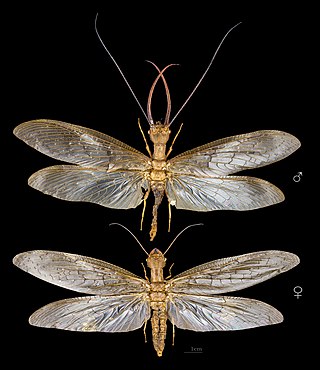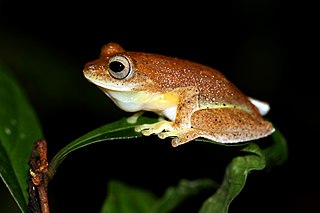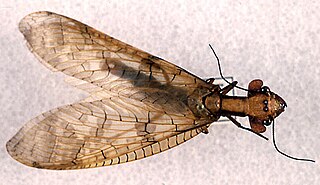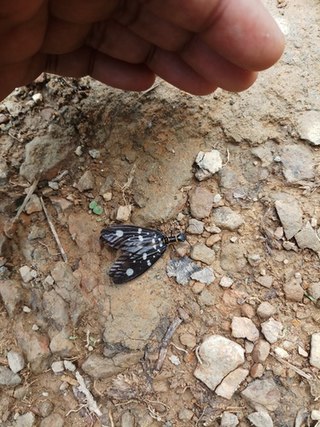
The black-rumped flameback, also known as the lesser golden-backed woodpecker or lesser goldenback, is a woodpecker found widely distributed in the Indian subcontinent. It is one of the few woodpeckers that are seen in urban areas. It has a characteristic rattling-whinnying call and an undulating flight. It is the only golden-backed woodpecker with a black throat and a black rump.

The yellow-browed bulbul, or golden-browed bulbul, is a species of songbird in the bulbul family, Pycnonotidae. It is found in the forests of southern India and Sri Lanka. The yellow-browed bulbul is mainly yellow on the underside and olive above with a distinct yellow brow. They are easily located by their loud calls but tend to skulk within foliage below the forest canopy. While its taxonomic classification has changed over time, it is currently the sole species within the monotypic genus Acritillas which is closely related to Hemixos.

Dobsonflies are a subfamily of insects, Corydalinae, part of the Megalopteran family Corydalidae. The larvae are aquatic, living in streams, and the adults are often found along streams as well. The nine genera of dobsonflies are distributed in the Americas, Asia, and South Africa.

The grey-headed bulbul is a member of the bulbul family, Pycnonotidae. It is endemic to the Western Ghats in south-western India, and found from Goa south to Tamil Nadu at altitudes up to 1200m. It is found in dense reeds or thickets mainly near rivers and swampy areas inside forests. They have a distinctive call that reveals their presence inside dense vegetation where they are hard to spot.

Draco dussumieri, also known commonly as the Indian flying lizard, the southern flying lizard, and the Western Ghats flying lizard, is a species of lizard in the family Agamidae. The species is capable of gliding from tree to tree. It is found principally in the Western Ghats and some other hill forests of Southern India. It is almost completely arboreal, found on trees in forests and adjoining palm plantations where it climbs trees to forage for insects and glides to adjoining trees by expanding the patagium, loose skin on the sides of the body which is supported by elongated ribs to act as wings. The skin on the sides of the neck is also extended to the sides using the hyoid bones of the tongue as support. During the breeding season males maintain small territories which they defend from other males while courting females. The male has a more colourful patagium than the female, and it prominently extends its yellow dewlap forward in display. Although living almost its entire life in trees, the female descends to the ground to lay eggs in soil. This is the species with the westernmost distribution within the genus Draco, the majority of species occurring in Southeast Asia.

Fishflies are members of the subfamily Chauliodinae, belonging to the megalopteran family Corydalidae. They are most easily distinguished from their closest relatives, dobsonflies, by the jaws (mandibles) and antennae. In contrast to the large jaws of dobsonflies, fishfly mandibles are not particularly noticeable or distinctive, and the males have feathery antennae similar to many large moths. Chauliodes pectinicornis, the "summer fishfly", is a well-known species in North America.

Indosylvirana aurantiaca, commonly known as the golden frog, is a species of frog endemic to the Western Ghats of India. The species is also known as the Trivandrum frog, the common wood frog, or the small wood frog.

Rhacophorus lateralis is a rhacophorid tree frog endemic to the Western Ghats in South India. It has several common names: small tree frog, Boulenger's tree frog, small gliding frog, and winged gliding frog. After its original description in 1883 by George Albert Boulenger, the frog was rediscovered in Coorg in 2000 and has since been found in many parts of the Western Ghats around southern Karnataka and northern Kerala. Along with R. malabaricus, it is one of the few anuran amphibians in India that constructs its nest above the ground using leaves.

The flame-throated bulbul is a member of the bulbul family of passerine birds and the state bird of Goa. It is found only in the forests of the Western Ghats in southern India. Formerly included as a subspecies of Pycnonotus flaviventris it has since been elevated to the status of a full species. They are olive-backed with yellow undersides, a triangular orange-red throat and a white iris that stands out against the contrasting black head. They are usually seen foraging in groups in the forest canopy for berries and small insects. They have a call often with two or three tinkling notes that can sound similar to those produced by the red-whiskered bulbul. The species has been referred to in the past by names such as ruby-throated bulbul and black-headed bulbul, but these are ambiguous and could apply to other species such as Rubigula flaviventris and R. dispar.

Mercurana is a genus of arboreal frogs belonging to the family Rhacophoridae. The genus was named from the only known species Mercurana myristicapalustris, which was described in 2013 from the Western Ghats of Kerala, India. The generic name was derived from and given as a tribute to Freddie Mercury, the late vocalist of the British rock band Queen, in combination with the Latin name for "frog". The frog is different from other related frogs in that it has extensively webbed toes, lives only in swampy lowlands, and lays its eggs on mud with which it carefully mixes leaf litter.
Puntius madhusoodani is a species of fish in the family Cyprinidae in Puntius genus. The species has been discovered in 2010, named and described jointly by Krishnakumar, Benno Pereira & Radhakrishnan and a study first published in Biosystematica in 2012. It was collected from Manimala River in Kerala, India, which has a running length of only 92 km and empties into the Vembanad Lake. Puntius madhusoodani is named after Prof. Dr. B. Madhusoodana Kurup, as an honour for his contribution towards the taxonomy and conservation of freshwater fishes of Kerala.

Platyneuromus is a genus of dobsonflies in the family Corydalidae. They are found in Mexico and Central America.

Nyctibatrachus robinmoorei, also known as Robin Moore's night frog or the Tirunelveli wrinkled frog, is a species of frog in the family Nyctibatrachidae, commonly known as the robust frogs. It was described in 2017, along with six other species in its genus, by the herpetologist Sonali Garg and her colleagues. A small frog, it has an adult male snout–vent length of 12.2–13.4 mm (0.48–0.53 in). It is mainly reddish-brown, with a light grey underside, light orangish-brown bands running from the eyes to the middle of the back, light brown limbs, and darker brown hands and feet. When preserved in ethanol, it is mostly brown, with light greyish-white undersides and light greyish-brown limbs.

Nyctibatrachus radcliffei, also known as Radcliffe's night frog or the Thiashola wrinkled frog, is a species of frog in the night frog family Nyctibatrachidae. It was described in 2017, along with six other species in its genus, by the herpetologist Sonali Garg and her colleagues. A medium-sized frog for its genus, it has an adult male snout–vent length of 32.8–38.3 mm (1.29–1.51 in). It is mainly reddish-brown, with a light flesh-red coloured underside, light brown limbs, and dark grey hands and feet. When preserved in ethanol, it is mostly dark grey, with grayish-white undersides.

Acanthacorydalis fruhstorferi is a species of dobsonfly native to Vietnam and China. It holds the title of largest aquatic insect by wingspan according to the Guinness Book of World Records at 21.6 cm. The title formerly belonged to the Brazilian damselfly Microstigma rotundatum.

Neoneuromus is a genus of dobsonfly endemic to the Indomalayan realm with 13 species. The larvae breed in montane streams. Adults are large with a forewing of 43 to 68 mm length and the body is yellow to red or brown with black marks on the head and pronotum. The wings are marked in dark patterning in the membrane and along the veins. They are closely related to Nevromus from which they are separated by the attenuation of the ninth sternum with an incised tip.

Chloronia is a genus of dobsonflies in the family Corydalidae.

Protohermes is a genus of dobsonflies in the family Corydalidae. Protohermes is the most specious and widely distributed genus within Megaloptera, but up to 85% of species are restricted to small endemic areas in Asia. This endemism may be a result of an association with high elevation and high slope streams in Northern Vietnam and China.

Parachauliodes is a genus of fishfly in the family Corydalidae. They are present throughout Eastern Asia, likely originating on the Korean peninsula before dispersing to the Japanese archipelago 15 mya.

Neurhermes is a genus of dobsonflies in the family Corydalidae.






















